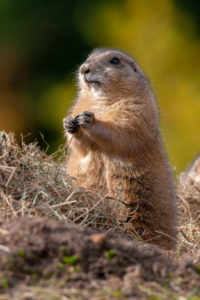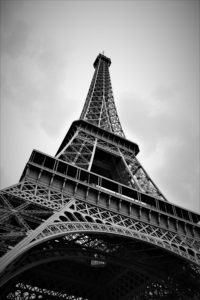
Biomimicry comes in two forms. The first is simple imitation of the appearance of nature. The ancient Greeks proportioned their buildings according to the golden ratio φ = (1 +√5)/2, which we can see in some patterns in nature. They believed this proportion was aesthetically pleasing. Natural motifs such as flowers and leaves often decorate our buildings even today. And we sometimes color concrete to mimic local rock.
The second kind of biomimicry, which is both an art and a science, imitates natural processes. The idea is that nature has many elegant and efficient solutions for the problems we face today. So why not learn from nature?
Imitation of natural processes may result in something that doesn’t resemble the original at all. For example, 19th-century Spanish settlers in Colorado needed to know how thick to make their adobe walls to stay warm in winter and cool in summer. They realized that Columbian ground squirrels already had the answer. These burrowing creatures knew how deep to dig to keep their homes at a comfortable temperature. The settlers measured the depths of the burrows and built their own above-ground homes accordingly. To this day, adobe homes there use this same wall thickness.
This kind of biomimicry can result in designs that make highly efficient use of energy and materials. That is, it’s a great way to achieve sustainability, or to comply with CALGreen.
Air conditioning inspired by termites
Although we think of termites as destructive pests, we can also learn from them. Termites build elaborate chimney-like mounds that may reach several meters in height for their nests. Even in extreme desert climates, these nests maintain stable interior temperatures.
While different species of termites use different architectural techniques, all their mounds facilitate internal convection currents. Through the day, sunlight strikes different surfaces on the mound, generating temperature gradients between surface and interior. These gradients induce currents of rising and falling air inside that maintain stable air temperatures. In addition, the surrounding soil provides insulation and heat capacity, further contributing to temperature stability.
The seven-story Eastgate Centre shopping- and office complex in Harare, Zimbabwe, makes use of similar principles. Building materials with high heat capacity store heat during the day and release it at night. Natural convection currents expel the heat generated by the building occupants. Fans supplement these natural mechanisms. The builders saved 10% of the original building costs by forgoing air conditioning. In its first five years of operation, the building owner saved $3.5 million in energy costs.
Passive air conditioning like this can help you design a net zero concrete building. It also contributes to resiliency. In the event of an extended interruption to the power supply, this type of building would maintain habitable temperatures. That would make it a good candidate for a community hub—or for sheltering in place. Another passive approach to cooling is passive radiative cooling, which mimics the structure of butterfly wings to reflect heat.
Impact-resistant materials
The diabolical ironclad beetle is amazingly crush-resistant. A car can run over it and not harm it. Similarly, the mantis shrimp withstands high-speed collisions, sustaining only localized damage—not catastrophic failure. How do they do that? The United States Air Force hopes to find out, using biomimicry to develop impact-resistant materials.
Arthropods such as beetles and shrimp have hard exoskeletons. In the mantis shrimp, the exoskeleton comprises both organic and mineral components. In the diabolical ironclad beetle, however, the exoskeleton is purely organic.
For both animals, though, the exoskeleton serves as a sort of armor. It has three layers: a waterproof epicuticle on the outside, an exocuticle in the middle, and an endocuticle on the inside. The two inner cuticles provide protection and support for the organism.
Impact-resistant materials are often composites, such as in the mantis shrimp. However, the diabolical ironclad beetle uses a different strategy: three kinds of lateral supports connect the top and bottom of its exoskeleton. The first, which researchers call interdigitated, interlocks the two parts like a mortise-and-tenon joint. This gives a stiff, strong response that resists crushing. The second, the latching support, hooks the two parts together but allows for deformation under compression. The third, the free-standing support, allows the two parts to slide against each other under load.
Having three different types of connection allows the beetle to withstand compression of up to 39,000 times its own weight. Yet the beetle can squeeze itself into small crevices in rocks or tree bark. Cockroaches have a similar ability. Such flexibility could be very useful for robots that need to fit into tight spaces—for example, in rescuing survivors in collapsed buildings after an earthquake.
Peace and quiet
If you’re reading this indoors, chances are that most of the ambient noise you hear is from fans. Fans keep your computer from overheating, and fans circulate the air in your home or office to keep you comfortable. All that noise comes from friction, and it wastes a lot of energy.
It turns out that wherever there’s circular flow in nature—whether eddies in a tide pool or water draining from a bathtub—it’s in the shape of a logarithmic spiral. This relates back to the golden ratio φ. Designing fans, impellers, and propellers in this shape has led one company to dramatic improvements in efficiency. Compared to conventional fans, they use 30 to 80% less energy and generate 75% less noise.
Good bones

Biomimicry can also help us make better use of materials. For example, the base of the Eiffel Tower must support the weight of the entire structure, just as human thigh bones support the weight of the upper body. In both cases the vertical load must transfer to a wider base, resulting in eccentric loading at the top of the lower members. Accordingly, the curvature of the tower’s base mimics the curvature of the human femur where it joins the hip.
Bones and trees make highly efficient use of materials to support loads. As living organisms, both bones and trees add material where they are most highly stressed. Bones also remove material where it’s not necessary. That optimizes strength and weight.
Car designers can use the same principles to make car bodies lighter while maintaining the necessary strength. This saves on fuel without sacrificing passenger safety in the event of a crash.
The cross section of a daffodil stem isn’t perfectly round. It’s more like a lemon than an orange. That helps the daffodil bend rather than break on a windy day. Such flexibility could be very useful in the design of utility poles.
On the other hand, in a tall building you don’t want too much motion. Occupying a tall building shouldn’t give you motion sickness! In that situation, it makes more sense to design it with an aerodynamic shape that lets the wind flow past it smoothly and minimizes lateral forces.
TED talks on biomimicry
Janine Benyus is perhaps the best-known proponent of biomimicry. View her TED talks here.
